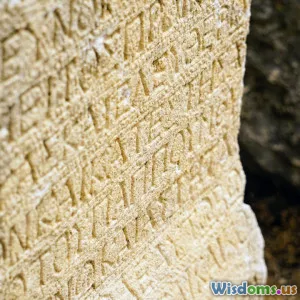
The Art of Ancient Writing and Its Secrets
9 min read Explore the mysteries and mastery behind ancient writings that shaped civilizations for millennia. (0 Reviews)
The Art of Ancient Writing and Its Secrets
Unlocking the mysteries of the past often begins with understanding the earliest methods of communication — ancient writing. Far beyond mere symbols scratched on stone or clay, these codes of language were revolutionary tools that enabled humans to record history, enforce laws, celebrate culture, and convey the deepest philosophies. Yet, despite millennia of scholarship, many aspects of ancient scripts retain an aura of mystery, enticing archaeologists and linguists alike.
Introduction: The Fascination with Ancient Writing
Imagine holding a tablet from Mesopotamia written in cuneiform or a scroll bearing Egyptian hieroglyphs—each mark a whisper from antiquity. The allure lies in the dual nature of ancient writing: it is art and information, baring secrets from societies that thrived thousands of years ago. These scripts are not only archaeological artifacts; they serve as bridges connecting us to humanity’s earliest stages of intellectual breakthrough.
Through them, we witness the dawn of literature, governance, religion, and commerce—essentially, the foundations of civilization. But the process of decoding these writings involves more than linguistic skill; it demands an understanding of history, culture, and craftsmanship.
The Evolution of Ancient Writing Systems
Writing systems emerged independently in different parts of the world, and their evolution underscores humankind’s universal desire to communicate and preserve knowledge.
Mesopotamian Cuneiform
Dating back to around 3200 BCE, cuneiform was one of the earliest writing systems used by the Sumerians in Mesopotamia (modern-day Iraq). Wedge-shaped impressions were made on clay tablets using a reed stylus, initially to keep trade records. Over time, cuneiform adapted to express abstract ideas and stories, including the famous Epic of Gilgamesh.
Example: Archaeologists discovered the Amarna Letters—clay tablets written in cuneiform from around 1350 BCE—revealing diplomatic correspondence between Egypt and various Near Eastern monarchs, showcasing the script’s political utility.
Egyptian Hieroglyphs
Ancient Egypt’s iconic hieroglyphs combined logographic and alphabetic elements and were employed extensively in religious texts and monumental inscriptions. The carvings and paintings made hieroglyphic writing both sacred and artistic.
Secret Revealed: The Rosetta Stone, discovered in 1799, was pivotal for modern understanding of hieroglyphs because it contained the same text in Egyptian hieroglyphs, Demotic script, and Ancient Greek, providing the key for its decoding by Jean-François Champollion.
The Indus Script
Used by the Indus Valley Civilization (c. 2600–1900 BCE), this script remains undeciphered, posing one of archaeology’s greatest mysteries. The symbols, often found on seals and pottery, suggest a highly advanced urban society. If decoded, this script could transform our understanding of South Asian ancient history.
Mayan Glyphs
The Maya developed a complex system combining logograms and syllabic scripts. Their inscriptions tell stories of historic rulers, rituals, and cosmology. The 20th-century breakthroughs by scholars like Yuri Knórosov demystified much of their writing, enabling a fuller picture of Mesoamerican culture.
The Secrets Embedded in Ancient Writing
Writing is more than communication; within its symbols lie cultural worldviews, social hierarchies, and hidden messages.
Symbolism and Artistry
Many ancient scripts are intricate artistic compositions. Egyptian hieroglyphs, for instance, were not only phonetic but also symbolic. The ankh symbol represented life, while the falcon was linked to the god Horus, transmitting religious beliefs through every text.
Preservation of Knowledge and Power
Writing systems often served to solidify political power by recording laws, decrees, and genealogies. The Code of Hammurabi, etched in cuneiform, is one of the earliest legal codes—laying down justice foundations within Babylonian culture.
The Role of Scribes
In many ancient societies, scribes held elevated status due to their literacy and knowledge. Their training was rigorous, encompassing language mastery, arithmetic, and rhetoric.
Insight: Mesopotamian scribes were trained in tablet schools called edubbas, where they copied texts for years—a tradition demonstrating the pivotal role of education in ancient administrative and cultural life.
The Challenges of Decoding Ancient Scripts
Decipherment is often an intricate puzzle of linguistic, historical, and cultural analysis.
- Lack of bilingual texts: Without a Rosetta Stone equivalent, many scripts resist interpretation.
- Script complexity: Some systems use vast symbol sets or contextual nuances.
- Lost languages: Some writings represent languages no longer spoken, further complicating efforts.
Case Study: Deciphering Linear B
Linear B, a script used by Mycenaean Greeks around 1400 BCE, was deciphered in the 1950s by Michael Ventris. Identifying it as an early form of Greek revolutionized Aegean archaeology by linking the Mycenaeans to classical Greek civilization.
Modern Technology and Ancient Writing
Today, technology fuels fresh discoveries.
- 3D Imaging: Scanning fragile tablets preserves details missed by the naked eye.
- AI & Machine Learning: Algorithms can detect patterns or correlate symbols faster than manual efforts.
- Digital Archives: The British Museum and other institutions enable global access to texts for collaborative research.
Example: In 2018, researchers used AI to analyze Mycenaean Linear B tablets, advancing understanding of agricultural practices and trade in ancient Greece.
What Ancient Writing Teaches Us Today
Beyond historical curiosity, ancient writing reminds humanity of our long-standing pursuit of knowledge and communication. It underscores:
- The importance of preserving cultural heritage.
- The evolution of linguistic diversity.
- How storytelling and record-keeping shaped social development.
For educators and archaeologists, these texts are invaluable teaching tools and inspire continued exploration.
Conclusion: Unveiling the Past, Inspiring the Future
The art of ancient writing is a testament to human ingenuity and the eternal quest to connect across time. Each script mastered or still shrouded in mystery invites us into the lives of our ancestors—their triumphs, beliefs, and complexities.
As technology and scholarship progress, the secrets encoded in ancient symbols continue to shed light on our shared heritage, reminding us that every stroke, wedge, and curve holds a story waiting to be unearthed, understood, and cherished.
References:
- Kramer, S. N. (1963). The Sumerians: Their History, Culture, and Character.
- Allen, J. P. (2010). Middle Egyptian: An Introduction to the Language and Culture of Hieroglyphs.
- Farmer, S., Sproat, R., & Witzel, M. (2004). Decipherment of the Indus Script—The Quest Continues.
- Coe, M. D. (1999). Breaking the Maya Code.
Explore ancient scripts and join the journey unraveling humanity’s earliest stories.
Rate the Post
User Reviews
Popular Posts





















